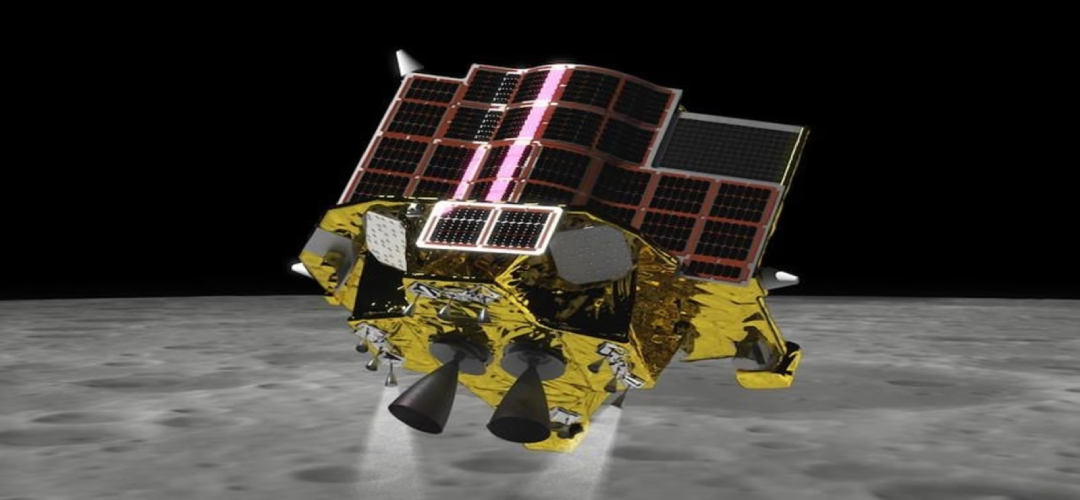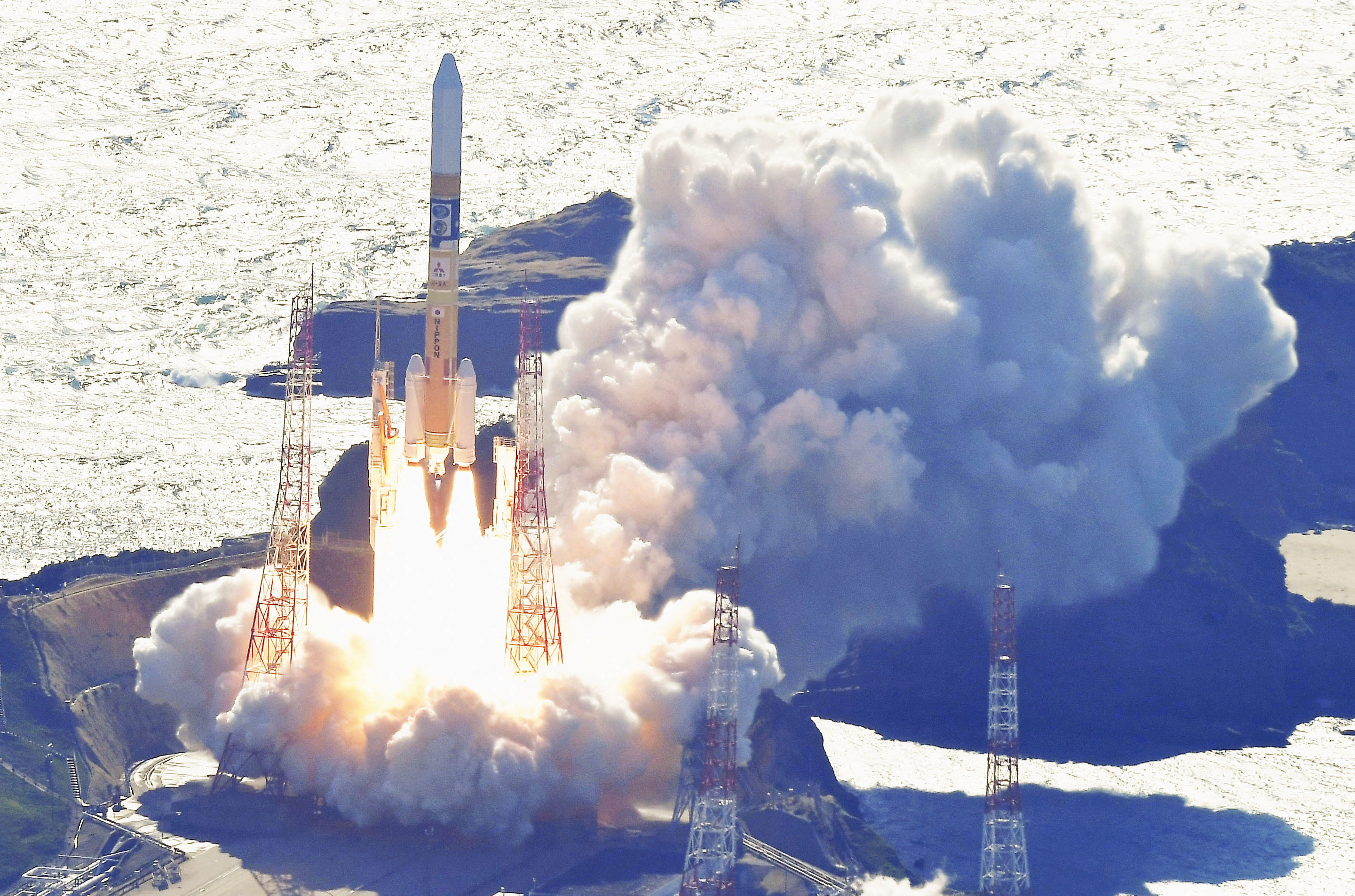Moonstruck Nippon
February 10, 2024 | Expert Insights

On January 20th, 2024, Japan joined the exclusive club of nations with a soft landing on the Moon. Despite a dramatic twist that left the lander precariously upside down, the mission, dubbed "SLIM" (Smart Lander for Investigating Moon), successfully touched down in a rugged area near the lunar equator. After failing to revive its batteries, it was shut down to conserve power; it fortunately revived once the lunar sunlight emerged, charging its batteries afresh.
This event marked a significant milestone in Japan's space program and reignited global interest in the Moon. But what sparked this renewed lunar frenzy, and what does it mean for the future of space exploration?
Background
Japan's journey to the Moon began long before SLIM's triumphant touchdown. The seeds were sown in the 1960s with the Lunar Orbiter Series, which captured the first close-up images of the lunar surface. This early foray paved the way for ambitious missions like Hiten, the first Japanese craft to escape Earth's gravity, and Muses-C, which returned the first asteroid samples to Earth. The Hayabusa missions then set a new standard, capturing and returning samples from near-Earth asteroids. These successes fuelled Japan's lunar aspirations, culminating in the SLIM mission and marking a new chapter in their lunar programme.
Japan's lunar goals are multifaceted, driven by both scientific curiosity and economic ambitions. Understanding the lunar history and evolution is a key focus. Missions like SLIM aim to analyse lunar rocks and soil, seeking clues about the Moon's formation and potential for water ice. Additionally, Japan is keenly interested in the potential of lunar resources like rare earth elements and helium 3. These valuable materials could play a crucial role in future space exploration and potentially offer economic benefits back on Earth.
Technological innovation is at the heart of Japan's lunar ambitions. SLIM showcased several groundbreaking technologies, such as its vision-based navigation system, allowing for precision landings in challenging terrain. This technology holds immense promise for future missions, enabling exploration of previously inaccessible lunar regions. Additionally, Japan is developing next-generation rockets like the H3, designed to be more powerful and cost-effective for future lunar missions. Moreover, autonomous rovers like those deployed by SLIM will play a crucial role in gathering data and exploring vast lunar landscapes.
Collaboration is another key pillar of Japan's lunar strategy. They are actively involved in international projects like NASA's Artemis program, aiming for the first crewed lunar landing since Apollo 17. In collaboration with India, Japan also plans the Lunar Polar Exploration Mission (LUPEX), scheduled for 2025. These partnerships allow for shared resources, expertise, and a broader scientific reach, propelling humanity's progress on the Moon further.

Analysis
The success of Japan's SLIM mission can be attributed to its groundbreaking technological advancements. Notably, the vision-based navigation system, utilising a camera and onboard computer for real-time image processing and comparison with pre-loaded satellite data, enables precise landings within 100 meters of the target, opening up previously inaccessible lunar regions for exploration. Furthermore, the lightweight design and fuel efficiency, achieved through innovative materials and engineering choices, reduce launch costs, allow for longer mission durations, and increase scientific payload capacity, promoting sustainable lunar exploration.
While the landing technology garnered significant attention, the scientific instruments onboard, such as the multi-band spectral camera and laser spectrometer, provided valuable insights into the Moon's composition and potential resource abundance, paving the way for future missions with even more sophisticated scientific capabilities. The development of SLIM wasn't without challenges, requiring complex algorithms and powerful onboard processing for the navigation system, as well as advanced materials and engineering solutions for lightweight design and fuel efficiency. However, these challenges fuelled innovation, resulting in a technological marvel that will undoubtedly shape the future of lunar exploration and scientific discovery.
A renewed wave of scientific exploration washes over the Moon, transforming its once silent visage into a vibrant tapestry of activity. Various nations and private entities contribute unique instruments and objectives to this burgeoning lunar symphony, each playing a distinct note in pursuing a deeper understanding of our celestial neighbour.
China's Chang'e program bravely sets its sights on the Moon's far side, a previously unexplored realm veiled from Earth's view. Missions like Chang'e-4, the first lander on the far side, have initiated investigations into its unique geological features and the effects of the space environment. Future endeavours like Chang'e-6 and -7 aim to delve deeper, unravelling the hidden history of this enigmatic region, assessing its potential resources, and potentially returning samples for further analysis.
India's Chandrayaan program focuses on the lunar south pole, a region suspected to harbour water ice deposits within its permanently shadowed craters. This life-sustaining molecule holds immense significance in the ongoing search for extraterrestrial life. Chandrayaan-1 confirmed the presence of water molecules, paving the way for Chandrayaan-2 to map and characterise these deposits in greater detail. Upcoming missions like LUPEX, a collaboration with Japan, will venture even deeper, seeking water-rich environments and clues to the Moon's evolution. Additionally, Chandrayaan-3 carries an instrument searching for potential biological signatures, raising the intriguing possibility of past or present life on the Moon.
Setting ambitious goals, NASA's Artemis program aims to return humans to the Moon and establish a sustainable presence. However, this program transcends mere footprints; science lies at its core. Crewed missions will conduct diverse investigations, study the Moon's geological composition, deploy advanced telescopes for astronomical observations, and conduct experiments under lunar gravity's influence. Establishing a lunar base will facilitate long-term research, enabling inquiries into radiation effects, resource utilisation, and the viability of the Moon as a springboard for deeper space exploration.
Private companies like Intuitive Machines join the lunar odyssey, contributing their unique scientific goals. Their missions often focus on specific lunar resources, such as regolith (lunar soil) and water ice, with an eye towards future commercial utilisation. By meticulously mapping and characterising these resources, they provide valuable data that paves the way for the development of lunar infrastructure and resource extraction, potentially laying the foundation for a thriving lunar economy. However, harnessing these resources presents significant challenges demanding a balanced approach considering technical hurdles, legal uncertainties, economic viability, and ethical implications.
The Moon's harsh environment poses formidable technical challenges. Mining in a vacuum, enduring extreme temperatures, and processing materials with limited resources necessitate significant engineering advancements. Efficient and cost-effective transportation systems are crucial for moving extracted resources within the lunar system or back to Earth. Overcoming these obstacles requires international collaboration, fostering innovative solutions and technological progress.
The legal landscape surrounding lunar resource utilisation remains uncharted. While the Outer Space Treaty prohibits national appropriation of celestial bodies, the specific regulations for resource utilisation are ambiguous. A robust international framework is essential to ensure responsible development, prevent conflict, and promote partnerships. This framework must address resource ownership, extraction rights, environmental protection, and equitable distribution of benefits, demanding complex negotiations and agreements among spacefaring nations.
The economic potential of lunar resources is undeniable. Water ice can be converted into fuel for deep-space exploration, rare earth elements can meet Earth's technological needs, and helium-3 holds immense promise for future fusion energy. However, the initial investment costs, technological development requirements, and transportation challenges might outweigh the near-term benefits. A thorough risk-reward analysis, coupled with international partnerships and public-private collaborations, is necessary to ensure the economic viability of lunar resource utilisation.
Assessment
- Ignoring ethical considerations in lunar exploration would be a misstep. Concerns about space militarisation and the weaponisation of resources demand international treaties and responsible governance. Equitable distribution of resources among nations and safeguards against exploitation are crucial aspects of resource ownership. Furthermore, environmental protection on the Moon is paramount, requiring responsible and sustainable mining practices to preserve its unique scientific and cultural value.
- Unlocking the Moon's potential necessitates a delicate balancing act. Embracing challenges, fostering international cooperation, and prioritising ethical considerations are crucial to transforming the lunar treasure trove into a boon for humanity.
- We can propel ourselves further into the cosmos by ensuring responsible development while respecting and safeguarding our shared celestial heritage. The Moon is not just a resource frontier; it holds the key to understanding our place in the universe, and we must treat it with the respect and responsibility it deserves.








Comments